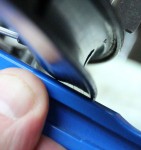|
This page was exported from Almost-Daily Diary
[ http://www.chainreactionblogs.com/diary ] Export date: Sat Nov 23 19:58:34 2024 / +0000 GMT |
If you ride in the rain, check your rims!!! How does this happen? If you ride in the rain, you pick up a mixture of road crud, water and ground brake pad that is as abrasive as sandpaper, so every time your brake is applied, you're wet-sanding the rim. Gradually the rim becomes thinner, and eventually gets to the point that it's no longer strong enough to hold the tire in place. That's when it literally explodes. It's hard to remember what a normal winter is like; we haven't seen rain in so long we've forgotten about last year! If you did ride your bike anytime between November and late May last year, chances are you rode in the rain. Many people who normally wouldn't ride in the rain eventually gave up and did ride, because the dry days were few & far between. As a result, we're seeing a lot more seriously rain-damaged bikes (not just wheels, but chains, cassettes and cranks too) than we'd normally expect. We need to be really clear about the fact that riding in the rain drastically accelerates wear & tear on your bike, especially high-performance bikes. One mile in the rain damages your bike at least as much as 100 miles on a normal (dry) day. Sometimes even worse. For those of us who ride no-matter-what, the smart thing is to have your "nice" bike and a separate "rain" bike. The "rain" bike is usually the bike you rode before buying your new cool lighter/faster/smoother machine, a bike that's not meant to be pretty but needs to be basically functional. You're going to install fenders on it, wider tires (yes, they slow you down but you need more traction in the wet) and cheap wheels, because the rims are going to wear out pretty fast. Sorry, there's nothing you can do about that, short of using a bike with disc brakes. You're going to be replacing chains and cassettes and chainrings far more often, due to wear, than on your nice bike... the but price of the parts will be far cheaper, because you're not worried about weight, you're worried about stuff that works. But for now, go check the rims on your bike and see what they look like. You don't want your wheel to explode on you. For what it's worth, I go through a set of rims every 18 months or so on my rain bike. Desending from Skyline in the rain does that; and if you want to accelerate the process absurdly, descend Kings Mtn in the rain. Why Kings Mtn? Because there's no point where you can let off the brakes. You're grinding away the rim the entire descent. On 84, the more-gradual grade means you use the brakes less and wind resistance helps to slow you down as well. How bad is Kings? I've gone through a set of brake shoes on just one descent. |
|
Post date: 2012-01-05 14:28:53 Post date GMT: 2012-01-05 22:28:53 Post modified date: 2012-01-05 15:20:04 Post modified date GMT: 2012-01-05 23:20:04 |
| Powered by [ Universal Post Manager ] plugin. HTML saving format developed by gVectors Team www.gVectors.com |